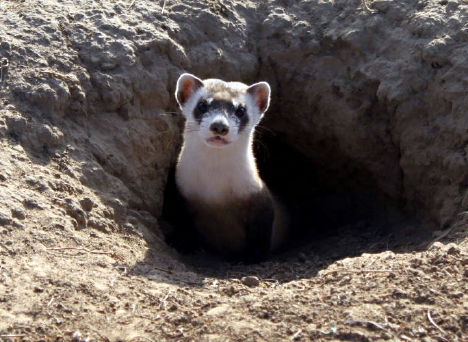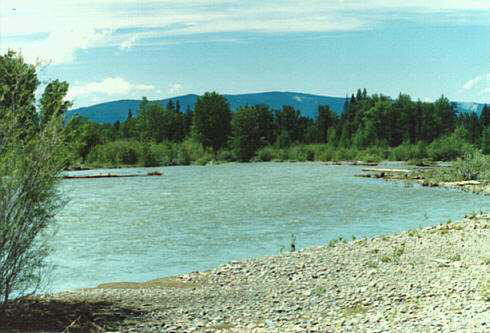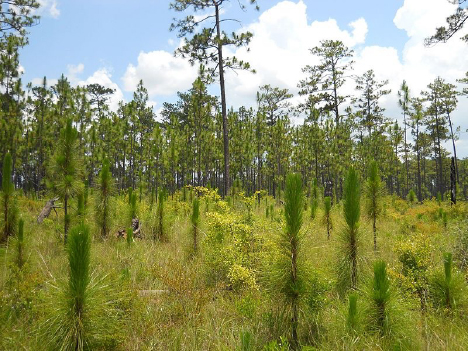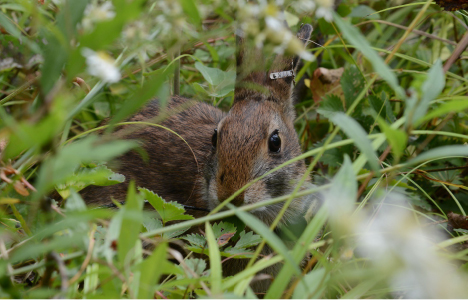Endangered Species Act Successes
The Endangered Species Act of 1973 (ESA) is designed to accomplish the conservation of fish, animals, and plants, as well as the ecosystems upon which they depend. One oft-debated question about the ESA is whether or not the law is a success. When people talk about “success” for the ESA, what do they mean? Most often, they mean the successful conservation of a species. This may include various subcategories of success, such as listing and survival, an improving population, or full recovery and delisting, The success stories displayed here, all drawn from The Codex of the Endangered Species Act, Volume I: The First Fifty Years, are more than that. They are examples of situations where innovative approaches to at-risk or ESA-listed species enabled successful outcomes for species and people. Successful outcomes include expanded habitat conservation opportunities, financial compensation for long-term commitments, conflict resolution, and even the conservation of species such that they were never listed under the ESA.
The greatest unquantifiable and overlooked success are the many species saved as a result of ESA programs and projects for listed species, their habitats, and ecosystems, within which a multitude of these other, non-listed species live.

Black-footed ferret. Ryan Hagerty/U.S. Fish and Wildlife Service National Digital Library.
Black-footed Ferret Reintroduction
The black-footed ferret, an iconic species unique to the Great Plains of the American West, was thought to be extinct prior to tis dramatic rediscovery outside of Meeteetse, Wyoming, on September 26, 1981. Unfortunately, this last wild population became afflicted by canine distemper and plague, and state and federal wildlife authorities made the decision to capture all surviving ferrets, rendering the species extinct in the wild by 1987, with just 18 individuals surviving in captivity.
These 18 ferrets formed the nucleus of a hugely successful captive breeding program, which to date has produced over 10,000 healthy black-footed ferrets. By 1991, the program was well-established enough to begin reintroductions to the wild, and the first reintroduction was conducted in 1991 on BLM and private lands in South Central Wyoming, in Shirley Basin, where 228 ferrets were released over a four-year period.
These were introduced as an experimental population under Section 10(j) of the ESA, a complex regulatory process that ultimately guaranteed that landowners would be held harmless for any incidental take of ferrets on their property. The only condition imposed on landowners was that if a landowner intended to completely eradicate prairie dogs (the sole source of food for the ferret) they must notify the Wyoming Game and Fish Department and the U.S. Fish and Wildlife Service and give the agencies the opportunity to (re)capture any ferrets on the property for relocation elsewhere. The lack of any land use restrictions in this rule prevented conflicts between the ferrets and private landowners, including private landowners whose property the ferrets entered from an adjoining plot.
But there was remained the need for more, independent reintroduced populations, including populations residing primarily on private land. Since 2013, the Fish and Wildlife Service has employed Safe Harbor Agreements (a tool developed in 1999 under the authority of Section 10 of the ESA) to extend similar regulatory assurances to landowners willing to host black-footed ferret populations on their property.
There are two unique challenges associated with black-footed ferret management. First, the ferrets depend upon prairie dog colonies, and prairie dogs are regarded as pests by landowners, and virtually always treated as such by law as well. Prairie dogs dig extensive underground colonies that disturb land, and they consume vegetation, creating conflicts with everything from livestock to development projects and even airports. They also host fleas that transmit sylvatic plague to prairie dogs and ferrets alike.
To address these challenges, the Fish and Wildlife Service’s recovery program, long led by recovery coordinator Dr. Donald “Pete” Gober, has had to innovate. The program was able to develop programmatic Safe Harbor Agreements with the same protections for landowners – unlimited take authorization – and pair them with funding for innovation and deployment of plague management tools including dusting for fleas and distributed plague vaccines though food pellets. These permits are “programmatic,” meaning they are issued to the recovery program rather than to each individual landowner, which insulates landowners from regulatory red tape and delays. Often, a landowner can enroll in the program and have ferrets on their property in a matter of weeks.
For the ferrets, even if landowners ultimately choose to have them removed, they can be successfully relocated. In the interim, they will have benefitted from the habitat provided by the landowners. And in many cases, a commitment to accept black-footed ferrets will prove permanent.
Thanks to this approach, there are now over 30 wild populations of black-footed ferrets, with more being planned. If funding and landowner engagement continue to be sustained, the species could be recovered and delisted from the ESA within the next decade.

The Blackfoot River, two miles east of Lincoln, Montana. Wikimedia.
Resolving Conflicts Between Humans and Large Predators
The Blackfoot River valley of Montana, made famous by the 1976 novella and 1992 film A River Runs Through It, is home to the Blackfoot Challenge, a unique landowner-led collaborative conservation organization. Formally established in 1993, the organization traces its roots to the 1970s, when local landowners came together to protect their river from pollution from mining tailings, timber harvest, and grazing practices, and with it protect their agricultural way of life as well. It’s long history of success includes stream and wetland restoration, native fish restorations, access for hunters and anglers and other public recreation, noxious weed mitigation, timberland restoration, and over 100,000 acres of conservation easements.
In the last 20 years, the Blackfoot Challenge has added a new dimension to its mission: reducing conflicts between grizzly bears, gray wolves, and livestock. This initiative began following a fatal human-bear encounter in 2001. In response, the group formed a Wildlife Committee, eventually including 45 members representing the Blackfoot Challenge, the U.S. Fish and Wildlife Service’s Partners for Fish and Wildlife, the U.S. Forest Service, the Natural Resources Conservation Service, the Montana Department of Natural Resources and Conservation, Defenders of Wildlife, The Nature Conservancy, Living with Wildlife Foundation, and the University of Montana.
The group began its work by surveying local ranchers and outfitters – listening to the local community – to understand their perspectives on grizzly bears and how they might coexist with bears. This enabled the group to set priorities for its work that reflected the needs and values of the local community, which included protecting human safety, protecting private property from bear damage, and protecting rural livelihoods.
The Wildlife Committee worked towards these goals through an iterative process of science, communication, and participatory projects, in which it surveyed the local community and held public meetings, then mapped and analyzed potential sources of conflict on the landscape, communicated its findings back to the local community, and adjusted its planning based on their concerns. Through the process, a number of programs emerged, including electric fencing to protect newborn calves from bear depredation, collection and composting of livestock carcasses to reduce bear attractants, general sanitation and bear-proofing, outreach and education programs, and a neighbor-to-neighbor communication system. Each of these required community support and involvement, incorporating solutions to community concerns.
The results of the Blackfoot Challenge’s grizzly bear program have been remarkable. Between 2003 and 2013, there was a 74% reduction in verified human/bear conflicts within their project area, and a downward trend in known grizzly bear mortalities, even as the bear population increased by approximately 3% per year. And between 2013 and 2019, there were just 2.6 average annual confirmed and probable livestock losses to grizzly bears out of a population of 16,000-18,000 head of livestock.
Because of the Blackfoot Challenge’s engagement with landowners, wildlife managers acquired more accurate information on when and where bears appeared, generating maps that they could use to improve management. In addition, there was an increase in trust and credibility among the many stakeholders, economic benefits for livestock operators whose losses were reduced, and an increase in the local community’s acceptance of the fact that grizzly bears had come to their valley to stay.
In 2007, the Blackfoot Challenge was able to build on this record of success and develop a similar program to manage conflicts with gray wolves that were moving into the valley. Established programs such as livestock carcass removals and electric fencing helped address wolf management issues. In addition, the group conducted a range survey with the assistance of local ranchers and then implemented additional management tools such as fladry – bright ribbons on wires to dissuade wolves – and range riding – the practice of increasing livestock herd supervision rates and monitoring of wolves – in order to increase livestock herd supervision rates, better understand wolf activity, and regularly communicate with livestock producers about the status of their livestock in relation to wolf activity.
Between 2006 and 2015, confirmed livestock losses to wolves averaged 2.2 depredations per year, and an average of 2.4 wolves were removed each year in response. These figures were both lower than in other areas of Montana, suggesting that the Blackfoot Challenge’s proactive wolf management activities were helpful, although there is no proof of causation.
The experience of the Blackfoot valley with grizzly bears and gray wolves is an example of successful collaborative conservation, and a model for other groups and regions where large carnivores are present or may be reintroduced. A landowner-led group turned the collective abilities of its members and partners towards solving a common problem, the coexistence of large predators with commercial livestock operations. It took the support and direct involvement of local landowners that helped develop programs that served their needs, while also relying on scientific research techniques to fit those programs to the landscape and the needs of the species. Finally, it engaged partners in federal government, state government, the NGO community, and universities to broaden its impact and leverage more resources and expertise.

Longleaf pines in DeSoto National Forest, Mississippi. Wikimedia.
Pioneering Commercial Restoration of Longleaf Pine Forests
Historically, the Southeastern United States was dominated by longleaf pine forests, which stretched across nine states from Virginia to Texas, covering 90 million acres. Under the branches of these majestic giants evolved a unique ecosystem, made up of species such as the endangered red-cockaded woodpecker, the threatened gopher tortoise, the threatened eastern indigo snake, dozens of lesser known threatened and endangered species, bobwhite quail, small mammals such as fox squirrels, more than 68 species of birds (notably the wild turkey), deer, unique species of reptiles and amphibians, pollinators, and nearly 900 endemic plant species found nowhere else.
Today, 95% of this forest is gone, and just a few million acres remain. The reasons for this loss are many, including the suppression of natural lightning strike and human-set fires that sustained the forests; harvesting of the slow-growing longleaf trees for masts for the navy’s sailing ships and later lumber that built homes, warehouses, factories, and infrastructure across much of the United States around the turn of the 20th century; clearing of land for agriculture after the longleaf forests were harvested; and conversion of these agricultural lands to forests comprised of faster-growing species such as loblolly pine and slash pine for lumber and for pulp and paper products to support movement of the pulp and paper industry to the Southeast in the 1940s, ’50s and ’60s.
In the last 25 years, a growing community of state and federal agencies, forest industry groups, landowners, researchers, and NGOs have been studying the longleaf pine ecosystem and working to restore it. Important actors in this space include the Longleaf Alliance (a non-government organization established in 1995), America’s Longleaf Restoration Initiative (a coalition of thirty-three state and federal agencies, private landowners, and other organizations established in 2005), the Natural Resources Conservation Service’s Longleaf Pine Initiative, the National Fish and Wildlife Foundation’s Longleaf Landscape Stewardship Fund, and numerous other public and private organizations.
The forest products industry remains an important political and economic force in the Southeast, and it too has been heavily involved in longleaf pine and also threatened and endangered species conservation, through programs such as the National Alliance of Forest Owners’ Wildlife Conservation Initiative.
For large-scale restoration of the longleaf pine ecosystem, however, the economics are challenging. Forestry companies are private, for-profit enterprises, and most of the tens of millions of acres they own are managed for intensive cultivation and rapid harvest of fast-growing species such as loblolly and slash pine. These trees are generally ready for harvest within twenty-five years. Longleaf pine, on the other hand, is slower growing, and can be harvested at most every forty-five years, and in the intervening years must be managed with controlled burns every four years to promote tree health and maintain the appropriate understory. This presents a more risky, less profitable business model, unattractive to most companies.
Thanks to funding under the federal Farm Bill and financial and political support from dozens of governmental and non-profit supporters, a new approach is being pioneered by the timberland investment company Resource Management Service, LLC (RMS). RMS manages forests on behalf of institutional investor owners, such as pension funds and educational endowments, and it has a fiduciary responsibility to maximize the return on their investments. But it also has a strong ethos and legacy of environmental stewardship, and in 2014 launched the Coastal Headwaters Longleaf Forest Conservation and Restoration Project in southwestern Alabama and western Florida.
RMS is working towards restoring two hundred thousand acres of working longleaf forests and functional longleaf ecosystem habitat to support approximately forty-five at-risk, threatened and endangered, and NatureServe G1/G2 species. Three-quarters of the land is forested, and of that just 10% is longleaf pine, the rest having been converted to loblolly.
To achieve this, RMS is placing conservation easements on its land, which place a perpetual obligation upon the landowner to manage the covered land as longleaf forest, including growing the forest to at least forty-five years of age before final harvest and burning the forest every four years to promote tree health and maintain the ground cover that was historically present in the region. Periodic thinning throughout the rotation will help maintain open canopy conditions to further enhance the herbaceous groundcover. The forest will be preserved as a working landscape that supports local economies while also improving water quality and availability, protecting at-risk, threatened, and endangered species, and maintaining a healthy, native longleaf ecosystem.
This undertaking represents the surrender of a significant potential return on the company’s investments. To close this gap, RMS pioneered a new approach to valuation of conservation easements. In order for their longleaf easements to be financially viable, the easement appraisals needed to reflect not only the value of the surrendered development rights but also both the additional management costs committed to for restoring and maintaining a functional longleaf ecosystem and the revenue foregone by harvesting longleaf pine every forty-five years instead of loblolly pine every twenty-five years.
All these factors were incorporated into the valuation of the easement and the payment RMS received from the project’s various donors when the easement was sold. If this approach spreads and is adopted widely, easements will become more feasible for large landowners and will put dollars to work for conservation in areas where it will have the most benefit.
The differences between this project and a traditional preserve, where land is purchased and set aside for conservation, are critically important for the future of threatened and endangered species. At first blush, this may appear akin to a simple grant program, and certainly it is similar in that donors are giving RMS money and RMS is using the money to manage lands for conservation.
But these are working lands. Unlike in a preserve, RMS will continue to grow, manage, and harvest commercial timber on this land. In doing so, it will support thousands of jobs in local communities, including in forest management, harvesting, manufacturing, and related industries, as well as the local tax base and economy. Preserve lands produce relatively little economic activity beyond tourism (in select cases) and pose the risk that they may not be adequately managed and maintained. In contrast, RMS has a financial interest in continuing to manage its newly restored longleaf pine forests to produce timber, and with it the company will also produce wildlife habitat.
This project will yield outcomes that are better for the local community and for wildlife. It may even help to keep species off the threatened and endangered lists. In October 2022, the U.S. Fish and Wildlife Service announced that the eastern population of the gopher tortoise, east of the Mobile and Tombigbee Rivers in Alabama, did not warrant protection. Its range includes the Coastal Headwaters Longleaf Forest Conservation and Restoration Project, and RMS’ work on its land is helping to secure that species for the future.

New England cottontail. U.S. Department of the Interior/Wikimedia.
Keeping the New England Cottontail Off the Lists of Threatened and Endangered Species
The New England cottontail, a rabbit indigenous to the northeastern United States, has been declining due to increasing displacement by the invasive eastern cottontail, which is better adapted to open areas created by increasing human development. The New England cottontail, in contrast, is more reliant upon early successional shrubland for forage and cover. In 2006 the U.S. Fish and Wildlife Service designated it an official candidate for listing under the ESA, and in 2011 it was announced that the New England cottontail would receive a final ESA listing determination in 2015.
This spurred state and federal conservation efforts, which grew into the New England Cottontail Regional Initiative, a collaborative conservation effort involving six states, the Fish and Wildlife Service, the Natural Resources Conservation Service, and the non-profit Wildlife Management Institute. The group developed the New England Cottontail Conservation Strategy, initiated captive breeding and translocation efforts, established a new National Wildlife Refuge to benefit the cottontail (the Great Thicket National Wildlife Refuge), and worked with partners including tribal organizations and local landowners to find opportunities to preserve or restore early successional shrubland.
Because this habitat is ephemeral, coming into existence following logging, controlled burns, and other management actions that open up the forest, but then disappearing as the forest matures, the Conservation Strategy did not focus solely on identifying and protecting preserves that could be maintained as shrubland indefinitely, but instead leveraged the concept of “metapopulations” of the species to conserve habitat on an evolving basis.
This presented numerous opportunities for creative conservation programs in cooperation with interested landowners. Rather than merely identifying potential cottontail habitat and then paying landowners to either buy it or manage it for cottontail, the partners sought out landowners with compatible land use objectives, taking advantage of synergy between what landowners wanted to do anyway and what the New England cottontail needs.
In order to reach private landowners, the cottontail conservation effort invested in communications products such as the 2017 publication “Best Management Practices for the New England Cottontail,” which is a guide for regional land managers, and also the 2018 New England Cottontail Outreach Strategy, itself an update of a 2012 document. The outreach strategy focuses on engaging landowners, conservation advocates, natural resource professionals, elected officials, local communities, other partners, and media.
Direct outreach to local landowners, communities, and media organizations has been critical. Rabbits are highly charismatic, and the conservation effort leveraged that with initiatives such as community events, seasonal marketing around the Easter holiday, and photo-ops with politicians. For direct contact with local landowners, the program used Natural Resources Conservation Service funding to hire staff to work with individual landowners and help them secure grants and technical assistance for designing and implementing management actions that benefitted the cottontail while considering the landowner’s objectives, such as through federal Farm Bill programs.
New England cottontail habitat is also prime habitat for white-tailed deer and other game species, and for birds such as the prairie warbler, blue-winged warbler, field sparrow, American woodcock, brown thrasher, and other songbirds. In total, cottontail habitat supports 65 other species of wildlife as well as numerous opportunities for outdoor recreation and tourism.
The cottontail effort joined forces with countless small landowners who were interested in these other species for personal reasons, as well as local sporting clubs, and was able to convince those already interested in conservation to make the New England cottontail part of their plans. This in turn provided those landowners with funding and other resources to achieve their own objectives, resulting in a classic win-win that will be sustainable because it meets the needs of people as well as the needs of rabbits.
The result of all this work was that in 2015, the U.S. Fish and Wildlife Service determined that the cottontail did not warrant listing under the ESA. In making this determination, the agency explicitly relied upon the continued implementation and success of the New England Cottontail Conservation Strategy. The New England Cottontail Regional Initiative has now renamed itself the Forest Conservation Initiative, in recognition of the broader conservation value of the cottontail’s habitat to other species throughout the region, and it continued to work with people in the region to ensure a healthy habitat for humans and wildlife alike.
